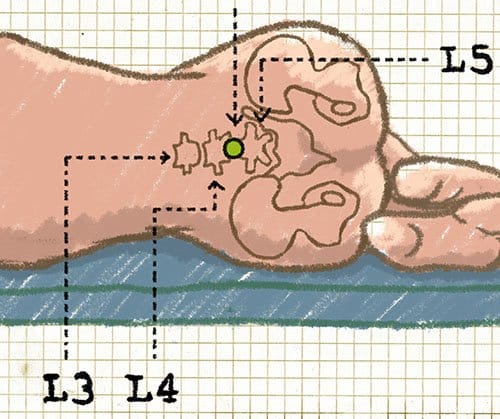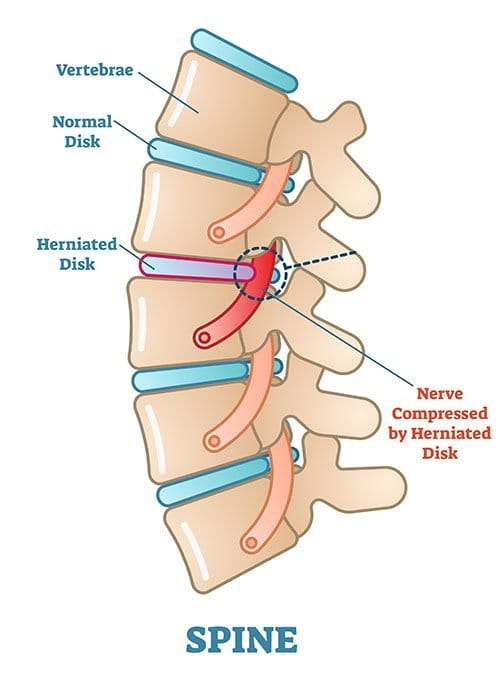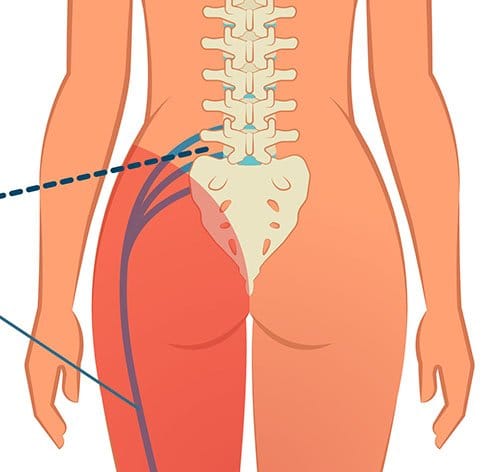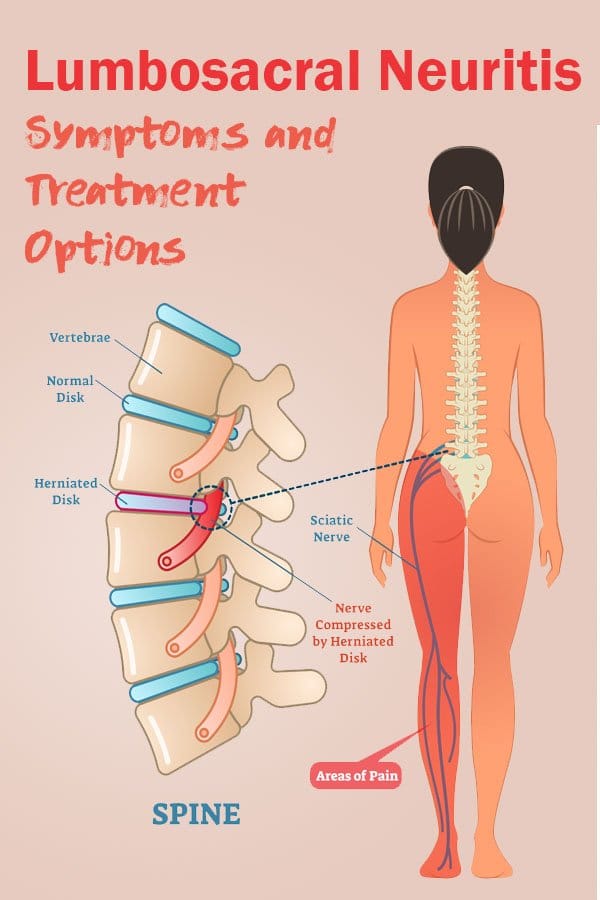Lumbosacral neuritis is a term that is used to describe an irritation and/or inflammation of several nerves that branch out from the spinal cord in the lower back, also called the lumbar region. In this article, we’ll examine lumbosacral neuritis symptoms and treatment options.
The lumbar region of the back houses spinal joints, soft pads between each vertebra called discs, muscles, blood vessels, and nerves. All of structures can get inflamed and possibly cause lumbosacral neuritis. Whenever you feel pain in the lumbar area, know that there are several possible trouble points that your doctor will have to check. This means that your doctor must make an accurate diagnosis to find the underlying cause.
The lumbar region includes up to 5 different vertebrae – designated as L1, L2, L3, L4, and L5. Another bone – one that is particularly large – is the sacrum. The sacrum can be found at the very base of the spinal column, connecting the spine to the pelvis.

The pain that stems from lumbosacral neuritis is most often caused by an irritation of a nerve that lines any of the L1-L5 vertebrae. The irritation can be at the nerve root or at the fibers of the nerve.
Lumbosacral neuritis can also be caused when some of the discs in the lumbar region become bulged due to inflammation. That means inflammatory substances that are naturally produced there, such as the prostaglandin, are leaking.
Ultimately, these degenerative changes in the nerves are the ones that cause the pain felt in the lumbar area. Now, these degenerative changes can also be caused by other contributing factors such as metabolic toxicity as well as metabolic disturbances.
When only one nerve is involved in a case of lumbosacral neuritis, it is called mononeuritis. On the other hand, when there are two or more nerves involved in this condition, then it is called polyneuritis.
Lumbosacral Neuritis Causes
Pain in the lumbar area of the spine can occur from an inflammation, irritation, herniated disc, compression (which can either be caused by a tumor in the spine or small bone spur), and/or endocrine condition (e.g. diabetes) that is affecting the region of the lower back.
Let us look at the possible lumbosacral neuritis causes in more detail:
1. Herniated Lumbar Disc

Just like any part of the human body, the discs between the vertebrae can become unhealthy. They can break open due to too much pressure and they can bulge and rupture. While you can get a herniated disc on any part of the spine, the lower back is usually more susceptible to this kind of injury.
A herniated lumbar disc can be the result of a spinal injury or regular wear and tear as we age. Tiny cracks or tears can appear on the discs, and they can lose their flexibility and dry out. When that happens, the disc will either break open or bulge. The effect of this is a pain in the lower back or lumbar region. If you have a herniated disc in your lumbar area, the pain will follow the path of the nerve, from the lower back, through the buttocks, to your leg.
2. Compression
One of the possible causes of lumbosacral neuritis is compression. It can occur due to many different reasons. One cause is the growth of a bone spur, which, due the natural movement of the spine, presses down on the nerves. Another cause for compression is the formation of a herniated disc, discussed above. Another factor that can cause compression on any of the nerves lining the lumbar region of the spine is a spinal column tumor.
When the tumor begins within the bones of the spinal cord, it is called spinal cord tumor. These tumors can be classified into two major types, extramedullary tumors (which develop in the network of cells that support and surround the spine) and intramedullary tumors (which begin within the cells of the spinal cord).
The growth of these spinal tumors can cause a good deal of pain. They can also cause a number of neurological problems. In some cases these tumors can even cause paralysis. Whether they are cancerous or not, these tumors are considered life threatening. They can also cause permanent disability.
Doctors may recommend any of these available modern treatment options: chemotherapy, radiation therapy, surgery, or medications. Your physician will determine which mode of treatment will be necessary or appropriate.
3. Infection
Serious infections can also cause pain in the lumbar area. An infection can usually appear because of a co-occurring conditions like diphtheria, HIV/AIDS, and others. Some infections can also cause an inflammation in the lumbar area and thus affect the nerves along the spinal cord.
4. Inflammation
Health conditions like hypothyroidism, diabetes, cancer, and other endocrine diseases can cause inflammation. This can cause increased pressure on the lumbar area of the spinal column, where the nerves are branching out. The pain caused by this pressure is called (you guessed it) lumbosacral neuritis.
5. Systemic Toxin Exposure
It has been shown that exposure to a number of toxins can lead to lumbosacral neuritis. That includes environmental toxins, the interaction of different medications, drugs, exposure to some chemicals and alcohol abuse.
6. Imbalanced Diet
Another possible cause for lumbosacral neuritis is dietary imbalance. If your diet is deficient in B vitamins like niacin and thiamin, minerals, and other vitamins, then you may be susceptible to lower back pain.
7. Scar Tissues
The presence of adhesions can cause a form of compression in the area of the surgery. This can eventually bring about an inflammation and lead to pain.
8. Chronic Acidosis
Another identified possible cause of lumbosacral neuritis is chronic acidosis. This is a condition where blood becomes acidic (in normal conditions your body fluids will usually remain alkaline). Acidity of body fluids can be caused by acid waste matter build-up in tissues. This condition develops gradually, over time, until it eventually results in acidosis. The main cause is imbalanced diet.
9. Foraminal Stenosis
The nerves in the lumbar region pass through what is called the spinal or vertebral foramen. From there they extend to the peripheral organs and other tissues, forming a network of nerves outside the spine. Foraminal stenosis is the narrowing of the foramina. This narrowing is caused by chronic osteoarthritis. The nerves in the foramina get pinched when the passageway gets tighter.
Lumbosacral Neuritis Symptoms
One of the most common lumbosacral neuritis symptoms expressed by patients is a shooting pain from the lower back down the legs.
Lower Back Pain
Lower back pain is the first complaint that you will hear from people who suffer from lumbosacral neuritis. Some report severe pain while other patients report manageable pain. Most of the time they will report that the pain they feel is usually present in the dermatomal distribution of the lumbar nerves.
The pain can usually be located where the irritated nerves are found. This type of pain is also referred to as a radicular pain. Most of the time, people who suffer from this condition will tell you that the pain they feel is continuous. The severity of the pain varies from one patient to the next.
Numbness and a Tingling Sensation
Another common symptom that is reported is either a tingling sensation in the affected areas, or in more severe cases, a feeling of numbness (constricted blood flow to the foramina). These are also the first signs of nerve damage, or what is known as nerve degeneration. People feel a tingling of the nerves along the area that is affected. Since the affected area is along the lumbar area, the tingling and numbness continue along with other related areas such as the hip and the legs. After a few weeks the patient will also feel numbness along the skin supplied by the affected nerves.
Weakness of the Muscles
One of the most common symptoms of lumbosacral neuritis is the feeling of weakness in the muscles. Note that motor fibers are also located within the nerves of the affected area. Since blood flow has become constricted, the motor nerve that is located there will undergo ischemic changes.
That means the weakness that one feels at the time is actually a sign that the motor nerve is degenerating. That means all the muscles that are being supplied by the motor nerve will get this feeling of weakness.
When several motor nerves are affected by this condition, it is called lumbosacral polyneuritis. That means more than one motor nerve is irritated or pinched simultaneously. This is a very serious condition which can lead to paralysis of the leg muscles.
Other Related Symptoms
Besides the main symptoms described above, there are other symptoms reported by people with lumbosacral neuritis:
- Reduced muscle control and muscle coordination;
- A reduction in muscle mass and muscular atrophy;
- Poor reflexes;
- Pain that is only experienced at night;
- Chronic pain experienced only during the day or night;
- A sharp pain, or burning pain;
- Inability to feel when the skin is touched or when pressure is applied;
- Inability to feel any changes in the temperature.
Diagnosis
Lumbosacral neuritis diagnosis can be a bit challenging, given all the possible underlying causes. There are a lot of factors involved and several nerves to test. An important step is identifying which disks and nerves are actually affected.
During the diagnosis, the doctor will perform tests to diagnose which type of lumbosacral neuritis is being experienced by the patient:
Lumbar Mononeuritis: neuritis which only affects a single nerve. It can affect either motor functions, or sensory functions, depending on the subtype.
Lumbar Polyneuritis: this type of lumbosacral neuritis affects more than one nerve in the lumbar area and is usually related to inflammation. Doctors will test for either motor or sensory nerve inflammation.
Mixed Nerve: the third type of lumbosacral neuritis affects both types of nerves – motor and sensory. This type will usually affect a few sections of the lumbar spine. If this is the case your doctor will diagnose your condition as a mixed neuritis.
The diagnostic tests that a doctor will recommend may include any of the following:
- Complete Blood Count – a CBC is used to determine nutrient imbalances, particularly imbalances in vitamins and minerals;
- Electromyogram – an EMG will be used to measure the level of nerve function as well as nerve conduction;
- White Blood Cell Count – this test is used to identify a possible infection;
- Nerve Conduction: is used to identify and isolate the possibly affected sensory or motor nerves;
- Nerve Biopsy: is used to identify possible nerve damage as well as look for neuropathy;
- X-Ray: your doctor may order an x-ray to check for possible structural damage in the spine. It can also be used to identify co-occurring conditions along the spinal cord, or for suspected spinal stenosis;
- Magnetic Resonance Imaging: an MRI is used to identify structural damage that cannot be completely verified using an X-Ray. If your doctor suspects cancer, aneurysm, tumors, or herniated discs, but can’t identify them using an X-ray then an MRI can be scheduled.
In many cases a doctor can already make a diagnosis based simply on a thorough physical examination. This can be done with the help of a patient’s medical history. Whenever a definitive diagnosis cannot be made, the doctor order a spinal x-ray or any of the diagnostic tests mentioned above. They will check for possible irregularities on the alignment of the bones along the spinal column.
Lumbosacral Neuritis Treatment
Lumbosacral neuritis treatment can be proposed only after a careful and accurate diagnosis has been made. A treatment plan will be selected depending on the particular underlying cause of the condition. For instance, if a patient’s lumbosacral neuritis is due to the onset of diabetic neuropathy then the treatment should include the management of diabetic conditions (preventing the persistent increase of the patient’s blood sugar).
Now, if the lumbar pain is actually caused by a tumor then an appropriate surgery will be ordered by the physician. After surgery, radiotherapy or its equivalent will be prescribed as well. Physical therapy alone will not benefit a patient with lumbosacral neuritis if the said condition is caused by a tumor.
Treatment Types
After a definitive diagnosis, a doctor can help provide different types of treatment approaches.
The treatment can involve only the intake of over the counter and/or prescribed medication. There are also at-home helps like lumbar cushions and assistive devices that can ease symptoms, or certain types of exercise, and stretching that helps strengthen the muscles in the lumbar region.
Your doctor may also suggest physical therapy or alternative treatment methods like chiropractic and acupuncture therapy. These treatment options are non-invasive and will not have a huge impact on the quality of life of the patient.
A doctor will only suggest a surgical treatment when there is no other alternative. That means there are no other alternatives to relieve the pain and alleviate the other symptoms of lumbosacral neuritis.
If there is a co-occurring condition such as an infection, then the infection should be treated and then the other symptoms should alleviate in time. Doctors will not focus on a symptomatic form of treatment. They will address the underlying condition for a complete resolution of the medical condition.

Pain Management and Treatment
Your doctor may recommend you vitamin supplements to help prevent the onset of pain. Vitamins B1, B12, B2, B6 and others may be suggested. The effects of taking these vitamins can be observed rather quickly, as fast as 30 minutes after intake.
Some cases can be managed with the intake of over the counter pain medications. However, some cases will require a prescription for pain medication from your doctor. In some cases, one may have to take non-steroidal anti-inflammatory drugs (NSAID).
Note that NSAIDs are used to treat cases of lumbosacral neuritis with severe pain. This means that over the counter medications have been tried and they weren’t effective in relieving the pain. In other cases, a doctor may prescribe the use of opioids for pain relief. An example of which is hydrocodone.
Some physicians prescribe the use of injectable steroids. These steroid injections are placed directly into a patient’s spine. The effect is immediate relief from both inflammation and pain. This form of pain treatment can be effective, though also quite expensive.
Home Remedies for Lumbosacral Neuritis
Various home remedies can be prescribed to help alleviate the symptoms and pain associated with this medical condition. The following home remedies have been found to be beneficial:
- Have a cup of soybean milk with a little honey every night before bedtime;
- Boil a cup of barley; once it’s cool, add some buttermilk and drink it once per day;
- Eat raw spinach and carrots at least few times per day;
- Soak in weekly Epsom-salt baths, with the water as hot as you can stand;
- Use a heating pad on the affected area;
- Make sure you are drinking plenty of water and keeping your body hydrated.
Thank you for reading! Check this article for some bad habits and activities that may be worsening your lower back pain.
Images via Depositphotos: normaals, TLFurrer


